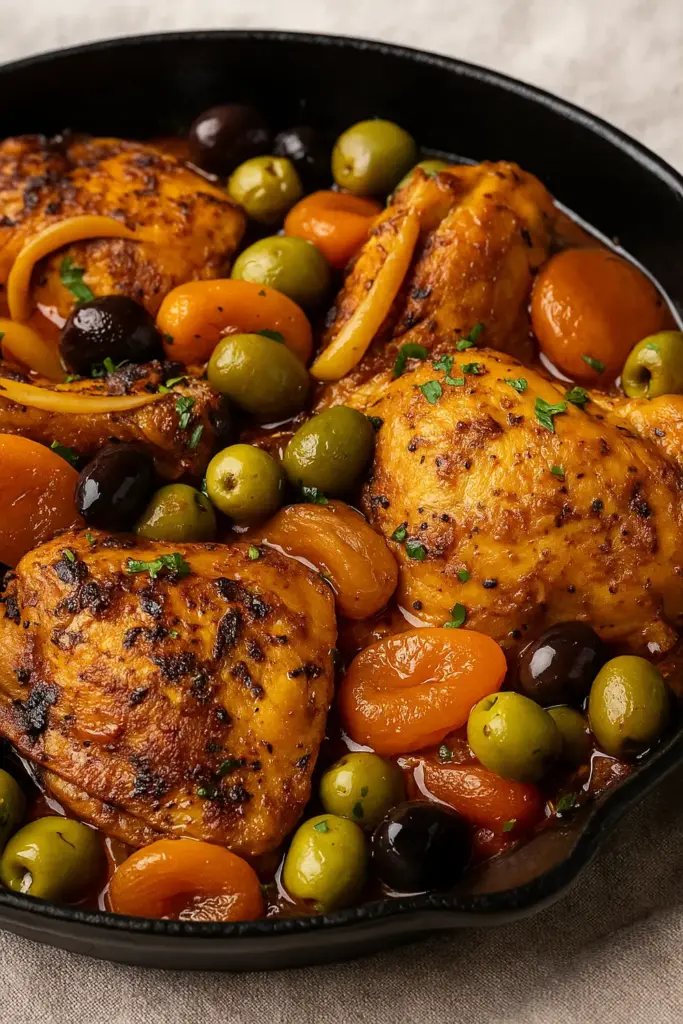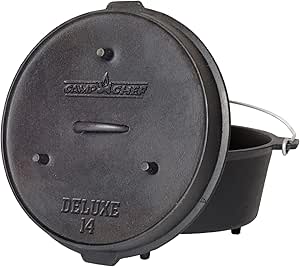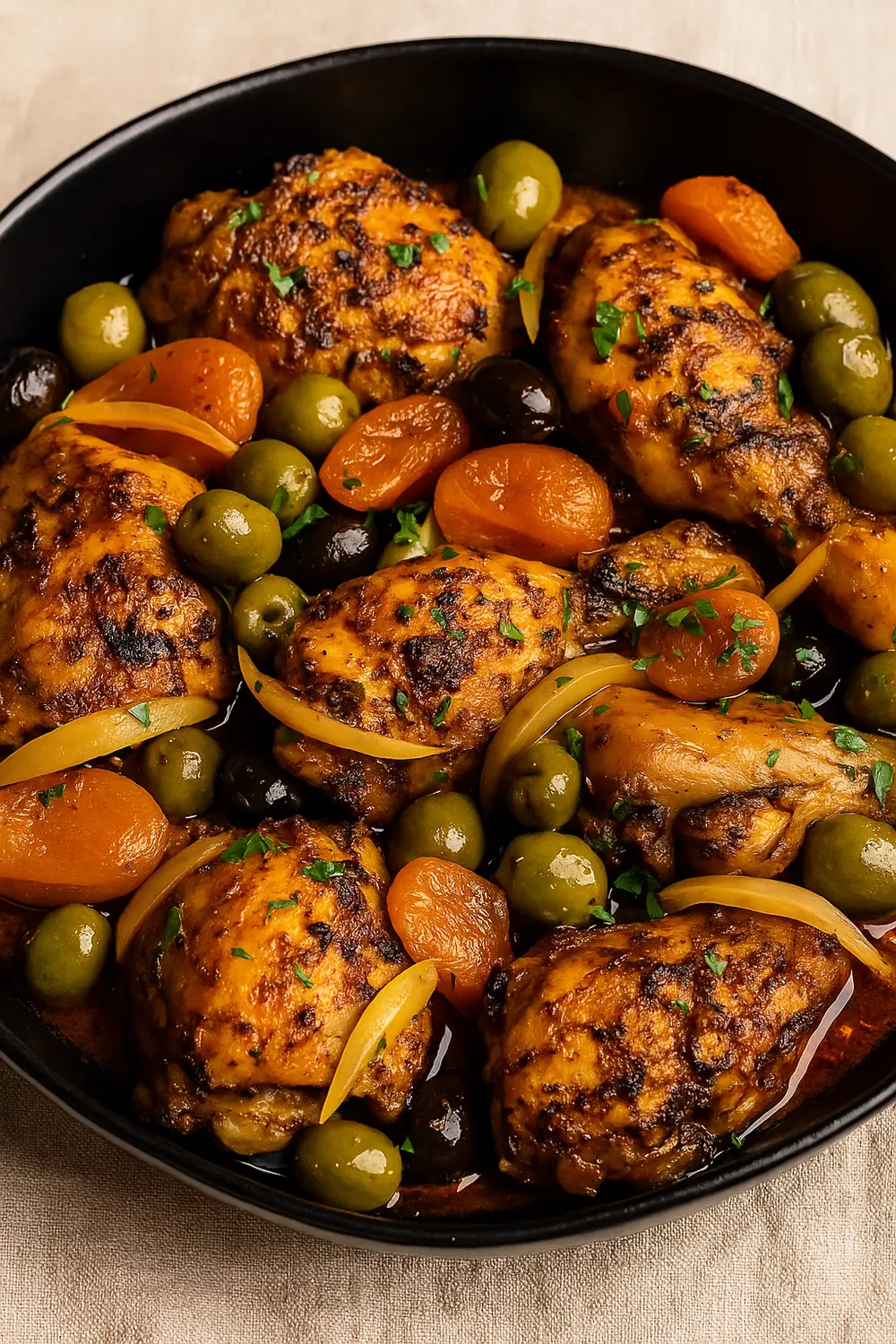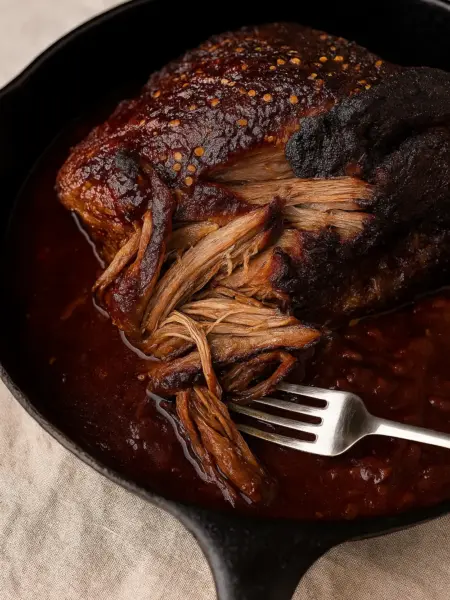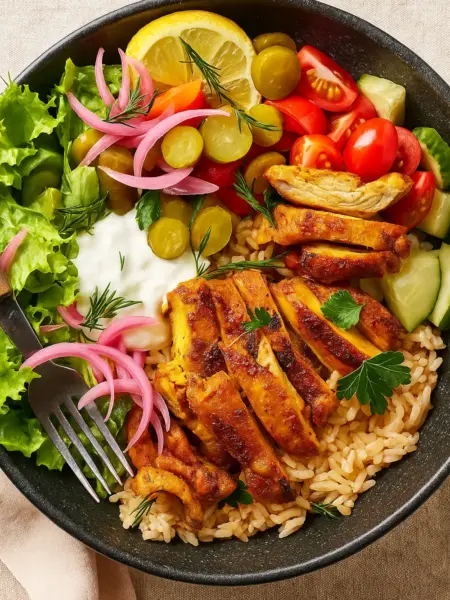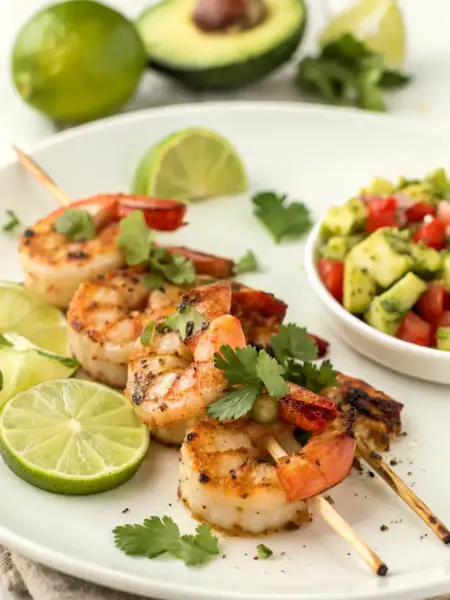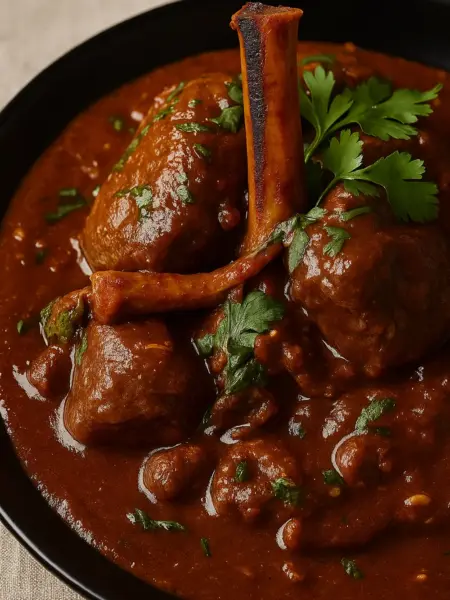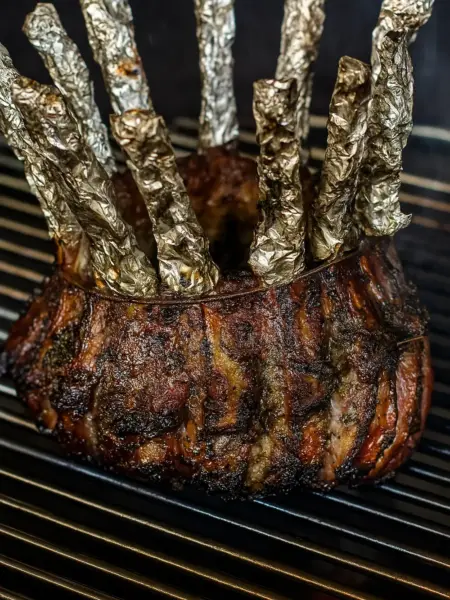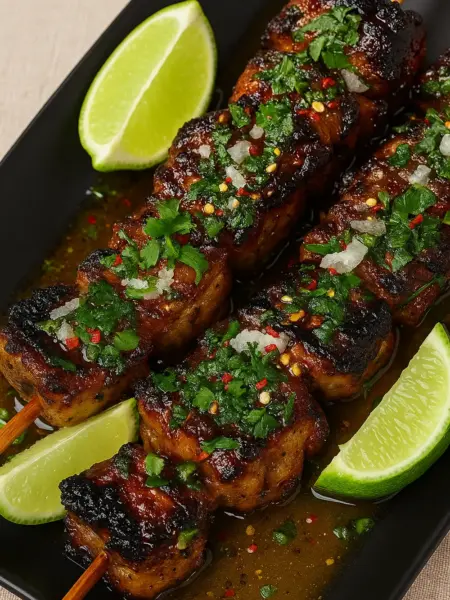This post may contain affiliate links, meaning I may earn a commission if you make a purchase, at no extra cost to you. I only recommend products I trust. Thank you for your support.
Chicken tagine is a classic North African stew made by braising chicken with spices, preserved lemons, olives, and often dried fruits, traditionally cooked in a conical clay pot called a tagine
Its origins are deeply rooted in the traditions of the Berber people of the Maghreb region, an area encompassing modern-day Morocco, Algeria, Tunisia, and Libya.
This Moroccan chicken tagine recipe features slow-cooked chicken thighs seasoned with warm spices like turmeric, ginger, and saffron, and complemented by sweet dried apricots, salty olives, and tangy preserved lemon.
Many recipes, especially those from outside Morocco, use cinnamon, but this can overpower the dish and make it taste too sweet and one-dimensional.
This chicken tagine recipe is simple to prepare, serves eight, has approximately 550 calories per serving, and is perfect for a cozy family dinner or special occasions.
We used a heavy-bottomed Dutch oven for this recipe, but you can also use a heavy-bottomed skillet with a lid or a covered braiser as alternatives to a traditional tagine pot.
Feel free to customize this Moroccan tagine recipe by adding vegetables like carrots, potatoes, or chickpeas, and swapping the apricots for prunes.
✅ Take a moment to read through the whole post for the ingredient list, expert tips, and equipment suggestions. The full recipe is right below!
Key Ingredients for This Moroccan Chicken Tagine Recipe
Here are the main ingredients you’ll need for this chicken tagine recipe:
1. Chicken Thighs
- For this slow-braised chicken tagine dish, the best option is bone-in, skin-on chicken thighs.
- The bone adds a deeper, more profound richness to the sauce, and the skin helps protect the meat, ensuring it stays incredibly juicy and tender as it slowly cooks.
2. Warm Spices
- This chicken tagine recipe relies on a thoughtfully curated mix of warm spices like cumin, ginger, coriander, paprika, turmeric, and saffron herbs.
- Saffron adds a luxurious aroma and delicate floral notes that help define the signature flavor of Moroccan cuisine.
3. Preserved Lemons
- Preserved lemons are lemons that have been cured in salt, which mellows their sharpness and gives them a uniquely salty, tangy flavor.
- It’s important to use only the rind, finely sliced, as the bitter pulp is typically discarded.
- If you can’t find the preserved lemons, use fresh lemon zest plus more lemon juice, but the flavor will be brighter and less fermented.
4. Olives
- A mix of green and black olives provides a wonderful briny contrast to the sweetness of the dried fruit.
- Violet olives are sometimes preferred over green ones, which can be a bit too salty in combination with preserved lemons.
- It’s best to use pitted olives, as they’re easier to eat and their briny flavor blends more fully into the sauce while the tagine cooks.
5. Dried Apricots
- The apricots provide a deep, natural sweetness that beautifully balances the savory and salty elements of the stew.
- For the best texture, it’s recommended to plump them in hot water before adding them to the pot.
- You can also swap the apricots for prunes or raisins.
6. Onions and Garlic
- These form the aromatic base of the chicken tagine sauce.
- Sliced onions cook down to a sweet, jam-like consistency, while minced garlic infuses the entire dish with a pungent, savory foundation.
7. Chicken Broth
- A good-quality chicken broth forms the flavorful base of the sauce, helping to meld the spices, lemons, olives, and dried fruit into a rich, cohesive stew.
- Opt for low-sodium broth so you can better control the salt level, especially with other salty ingredients in the dish.
8. Olive Oil
- Olive oil is essential for sautéing the aromatics and lightly browning the chicken before braising.
- It also adds a smooth, fruity richness that enhances the depth of flavor in the finished tagine.
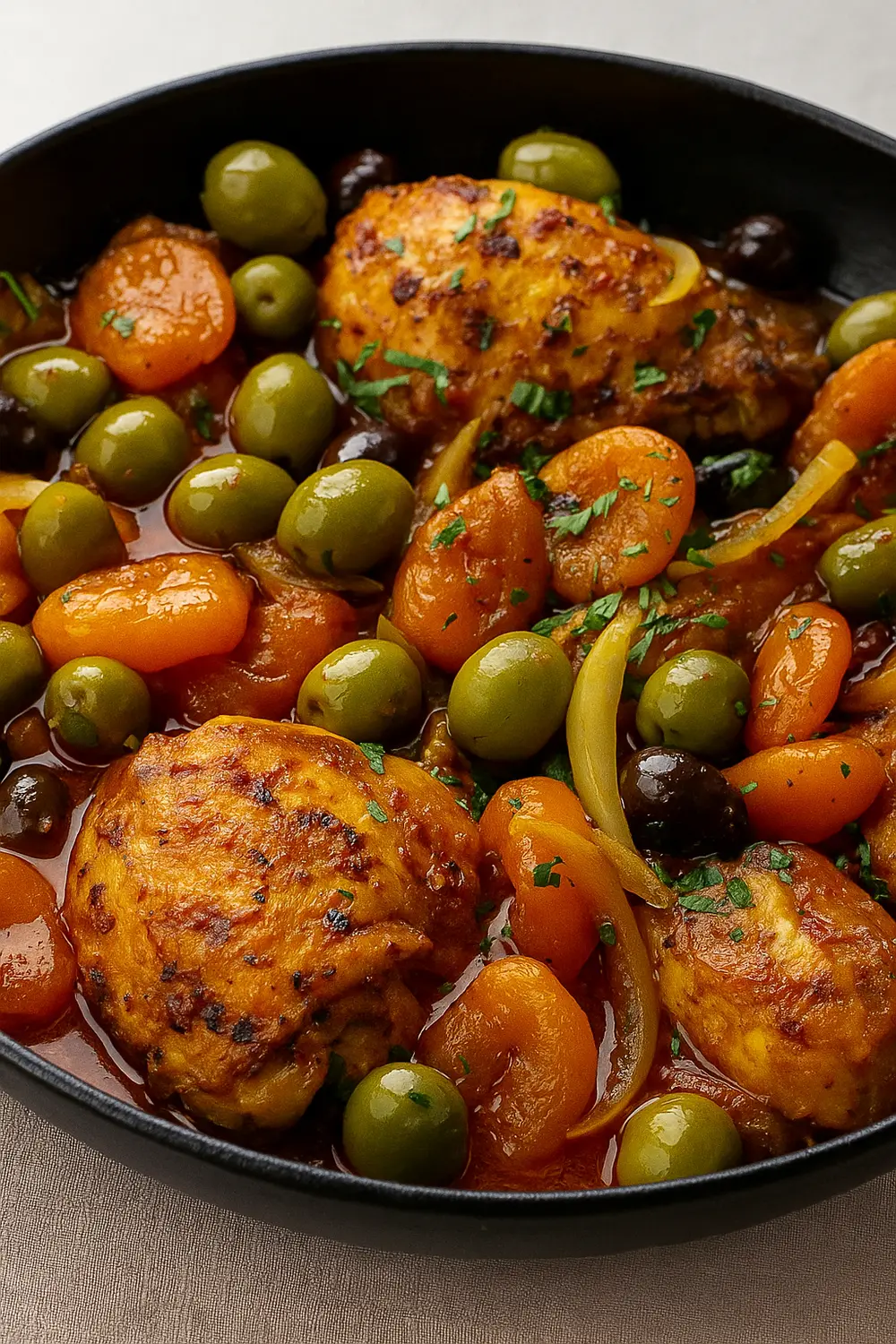
Essential Tools for Making Chicken Tagine
Here are the essential kitchen tools you’ll need to make this chicken tagine;
- Tagine Pot: The traditional clay tagine, with its shallow base and tall lid, circulates steam to keep food moist and meld flavors. If unglazed, cure it first by soaking in water, rubbing with oil, and baking to prevent cracking.
- Dutch Oven or Skillet: A heavy-bottomed Dutch oven, cast-iron braiser, or covered skillet makes an excellent tagine alternative, retaining heat evenly and sealing in steam for tender, flavorful chicken.
- Tongs or Large Spatula: Sturdy tongs or a wide spatula let you turn chicken without tearing the skin and safely transfer it in and out of the pot while keeping your hands away from hot oil and steam.
- Wooden Spoon or Silicone Spatula: Ideal for stirring and scraping up the browned bits that deepen the sauce’s flavor, these tools do the job without scratching your cookware.
- Chef’s Knife: A sharp, well-balanced chef’s knife makes quick, precise work of cutting chicken, slicing preserved lemons, and chopping vegetables safely.
- Cutting Board: A sturdy cutting board gives you a stable surface for prep, with separate boards for meat and vegetables to prevent cross-contamination.
- Measuring Spoons & Cups: Accurate measuring tools help keep the spice, broth, and ingredient ratios just right for balanced, consistent flavor.
Why You’ll Fall in Love with this Moroccan Tagine
This Moroccan chicken tagine is beloved for a number of reasons;
- Rich in Protein: Tender chicken thighs deliver around 42 grams of protein per serving, helping to support muscle growth and repair.
- Healthy Fats: Olive oil and olives provide monounsaturated fats, which are linked to improved heart health and overall wellness.
- Rich in Nutrients: You’ll get vitamin A from apricots, vitamin C from lemon and herbs, and iron from chicken, with extra boosts from the spices and dried fruit.
- Anti-inflammatory Properties: Turmeric, ginger, and saffron provide compounds like crocin and crocetin, celebrated for their antioxidant and anti-inflammatory effects.
- Fiber & Phytonutrients: Dried fruit and vegetables add digestion-friendly fiber and plant compounds that keep you feeling satisfied.
- Perfect Anytime: It’s a complete one-pot meal that’s elegant enough for guests but simple enough for a cozy weeknight.
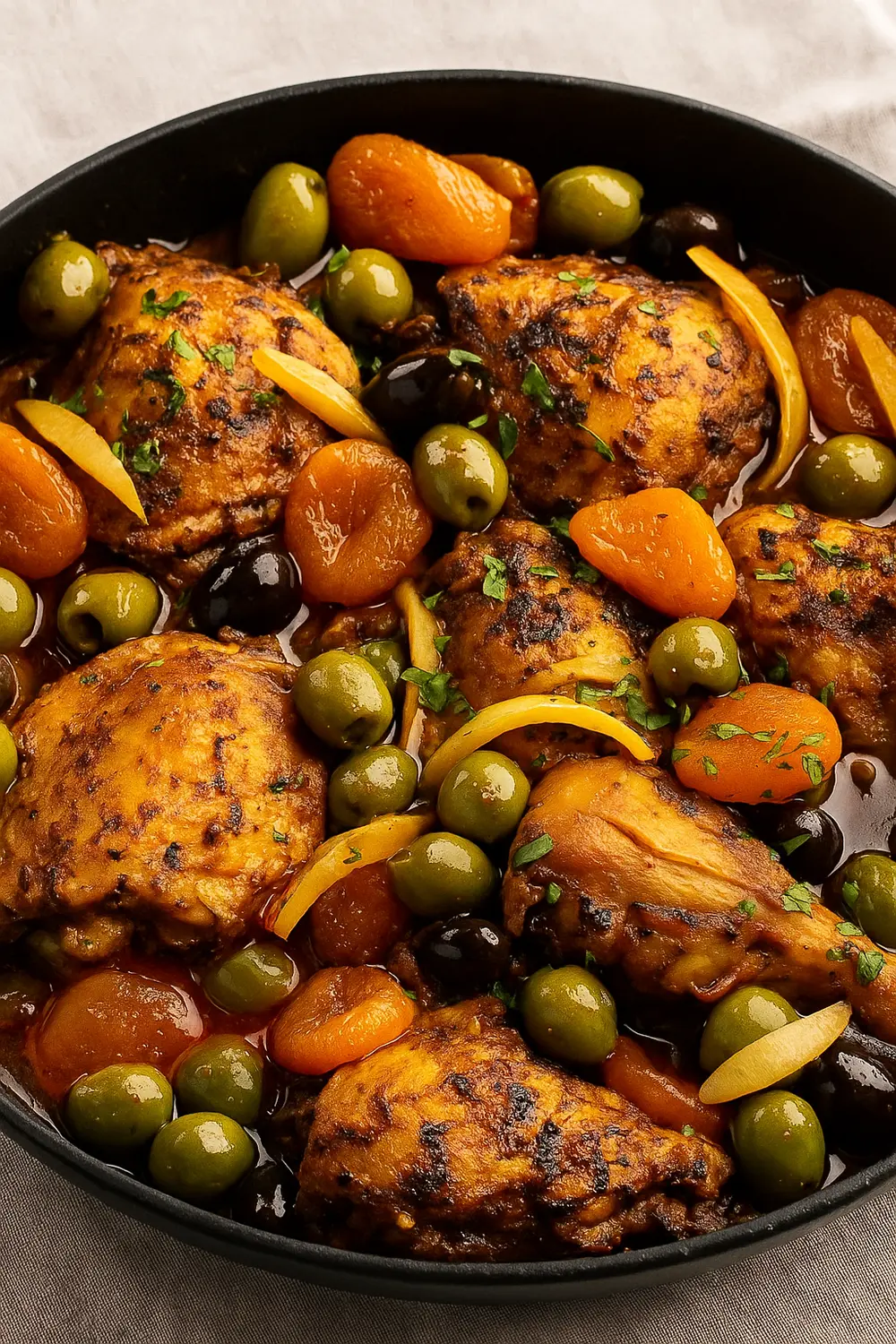
What to Serve with a Moroccan Chicken Tagine
Here are the best accompaniments to round out your Moroccan chicken tagine and create a complete, flavorful meal:
- Couscous: The light, fluffy grains are a classic chicken tagine pairing, perfect for soaking up every drop of the flavorful sauce.
- Moroccan Bread (Khobz): This crusty, slightly chewy bread is ideal for scooping up the tender meat and rich sauce.
- Basmati or Saffron Rice: Soft, fragrant rice, especially with a hint of saffron or turmeric, lets the tagine spices shine without competing with them.
- Roasted Root Vegetables with Ras el Hanout: Carrots, parsnips, and sweet potatoes roasted in Morocco’s signature spice blend make a colorful, fragrant side.
- Grilled or Steamed Zucchini & Eggplant: Light, smoky vegetables add freshness and a subtle charred flavor that pairs well with the chicken tagine’s richness.
- Yogurt-Mint Sauce or Labneh: Cool, creamy, and refreshing, this pairs beautifully with the warm spices of the Moroccan tagine.
- Preserved Vegetable Mezze: Tangy and flavorful, these pickled vegetables cut through the richness and add a burst of brightness.
- Zaalouk (Moroccan Eggplant Dip): A silky, smoky eggplant and tomato side dish seasoned with paprika, cumin, and garlic.
- Harira Soup: A light Moroccan tomato-lentil soup served before or alongside the tagine for a traditional multi-course feel.
- Minted Yogurt or Labneh Dip: Cooling and creamy, with fresh mint or a squeeze of lemon, this balances the Moroccan tagine’s warm spice profile.
Chef Tips for Making the Best Chicken Tagine
A few simple techniques can elevate your tagine chicken dish to the next level.
- Don’t Skimp on the Sear: Browning the chicken deeply for 8 to 10 minutes is a critical step that builds a foundational layer of flavor, known as “fond,” for the entire sauce.
- Bloom the Spices: Briefly sautéing the spices with the onions and garlic before adding any liquid helps to unlock their aromatic oils and create a more robust flavor.
- Cook Low and Slow: The most common mistake is cooking too hot, but the secret to a tender, juicy chicken tagine is a slow simmer that melds flavors without drying the chicken.
- Watch the Liquid: Start with minimal liquid since the chicken and onions will release plenty of moisture, and if the sauce is too watery at the end, just remove the lid and let it reduce for a few minutes.
- Balance the Salt: Preserved lemons and olives are already quite salty, so be conservative with your salt during the cooking process and adjust at the very end.
- Use Quality Ingredients: Fresh ginger, good quality spices, and plump dried apricots will make a noticeable difference in the final taste.
- Make-Ahead: Chicken tagine tastes even better the next day, so prepare it in advance, refrigerate, and reheat gently for a dish where the flavors have deepened and blended beautifully overnight.
Final Remarks
With tender, bone-in chicken thighs, sweet caramelized onions, and bursts of briny olives and preserved lemon, this Moroccan chicken tagine is a beautiful harmony of savory, sweet, and citrusy flavors.
It’s wonderfully versatile too; swap chicken for lamb or fish, apricots for prunes or raisins for extra sweetness, or toss in a handful of chickpeas for more heartiness.
Serve it over fluffy couscous, pillowy flatbread, or even a bed of herbed quinoa to soak up every drop of that rich, aromatic sauce.
If you give this Moroccan chicken recipe a try, we’d love to hear about it, share your twist, or let us know how it turned out in the comments.
You’ll find the full recipe and step-by-step instructions just below.
Moroccan Chicken Tagine
This easy Moroccan chicken tagine recipe serves eight and is made by simmering chicken thighs in a Dutch oven with preserved lemons, olives, saffron, and dried apricots.
Ingredients
For the Chicken
For the Spice Blend
For the Flavor Base
How to Make Chicken Tagine (Step-By-Step Instructions)
Prep the Chicken and Season
- Pat the chicken thighs dry with a paper towel.
- In a small bowl, combine all the spice blend ingredients and rub the mixture generously over the chicken, ensuring all surfaces are coated.
- Season with salt and pepper.
Sear the Chicken
- In a tagine, heavy Dutch oven, or skillet, heat 2 tablespoons of olive oil over medium-high heat,
- Place the chicken thighs skin-side down in a single layer.
- Don't overcrowd the pot; sear in batches if necessary.
- Brown the chicken deeply for 8 to 10 minutes until the skin is a rich golden-brown and releases easily from the pan.
- Flip and sear the other side for just 1 minute.
- Remove the chicken and set aside.
Build the Flavor Base
- Reduce the heat to medium.
- Add the remaining 1 tablespoon of olive oil and toss in the sliced onions.
- Sauté slowly until they soften and begin to caramelize, about 7 minutes.
- Add the minced garlic and cook for another 30 seconds until fragrant.
Bloom the Spices and Deglaze
- Now add the minced garlic, ground ginger, cumin, coriander, sweet paprika, turmeric, cayenne pepper, and saffron threads.
- Stir and let the spices bloom for 1 to 2 minutes.
- Pour in the chicken broth, scraping the bottom of the pan to loosen any last bits of flavor.
Assemble the Chicken Tagine
- Return the seared chicken thighs to the pot, nestling them into the liquid skin-side up.
- Add the carrots, soaked apricots, and half of the olives and fresh herbs around the chicken.
- Arrange the sliced preserved lemon rinds on top.
Simmer the Chicken
- Reduce heat to low and simmer gently.
- Cover the pot with a tight-fitting lid and let it braise for about 45 to 60 minutes, or until the chicken is fork-tender.
- The exact cooking time will depend on the size of your chicken pieces.
- Check occasionally to ensure it's not scorching, adding a splash of hot water if needed.
Finish and Serve
- Once the chicken is cooked to perfection and the sauce has slightly thickened, remove the tagine from the heat.
- Just before serving, stir in the remaining olives and fresh herbs.
- Taste and adjust for salt, keeping in mind the salinity of the olives and preserved lemons.
- Serve the chicken tagine directly from the pot over a bed of warm couscous or with Moroccan bread to soak up every last drop of the rich sauce.
Nutrition Facts
Servings 8
Serving Size Approximately 1½ cups
- Amount Per Serving
- Calories 550kcal
- % Daily Value *
- Total Fat 25g39%
- Saturated Fat 6g30%
- Cholesterol 140mg47%
- Sodium 550mg23%
- Potassium 900mg26%
- Total Carbohydrate 24g8%
- Dietary Fiber 4g16%
- Sugars 12g
- Protein 42g84%
- Vitamin A 1200 IU
- Vitamin C 18 mg
- Calcium 80 mg
- Iron 3.5 mg
* Percent Daily Values are based on a 2,000 calorie diet. Your daily value may be higher or lower depending on your calorie needs.
Note
Keep the heat low and the simmer gentle, as rapid boiling can toughen the meat, while high heat may dry out the chicken and scorch the pan.
Use preserved lemon sparingly, keeping only the rind and discarding the bitter pulp for a well-balanced flavor.
Preserved lemons and olives add plenty of salt, so season lightly at first and adjust to taste at the end.
If you’re using a new clay tagine pot, cure it first by soaking it in water, then rubbing the inside with oil and baking it in the oven to strengthen and protect it from cracking.

